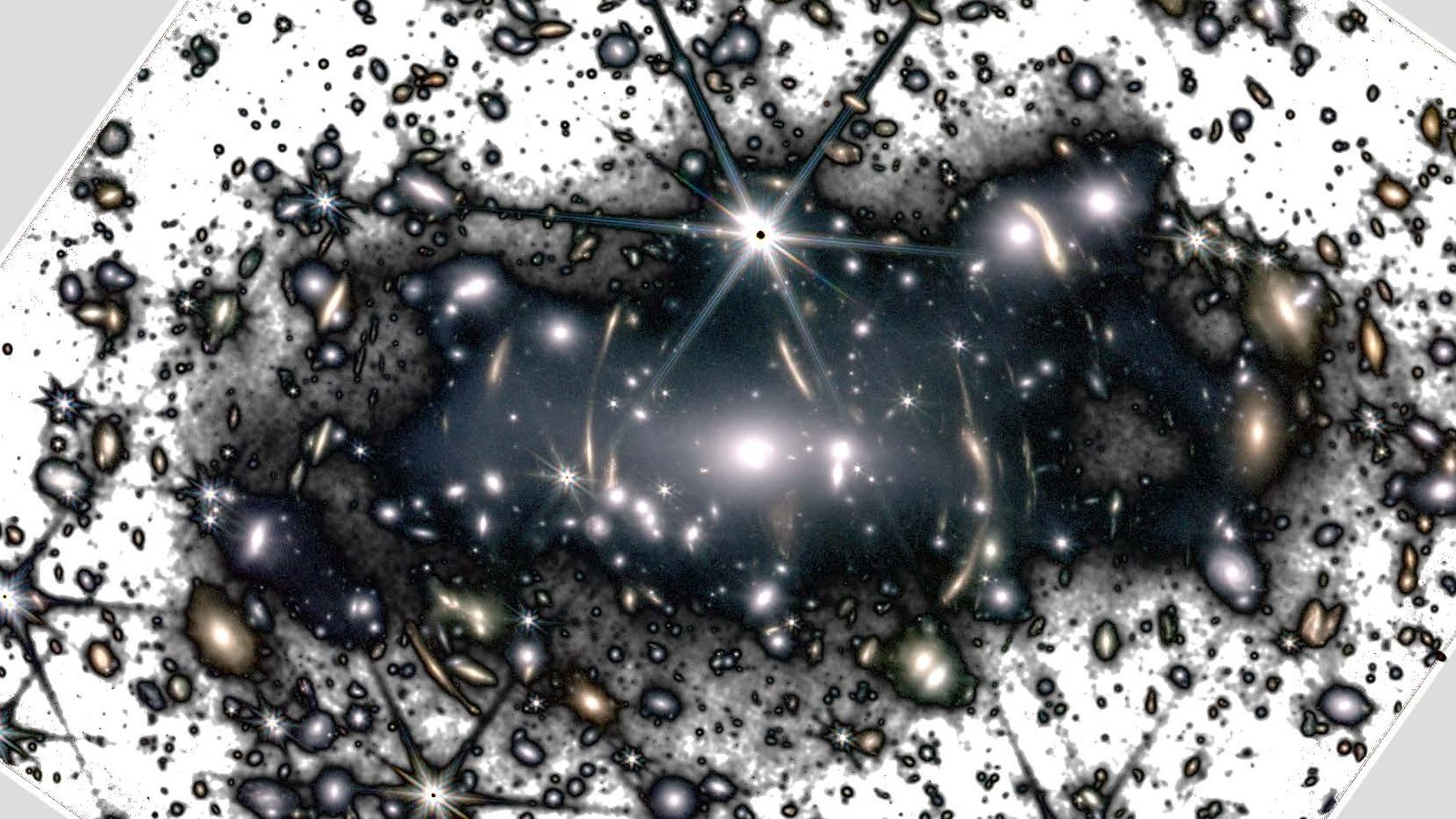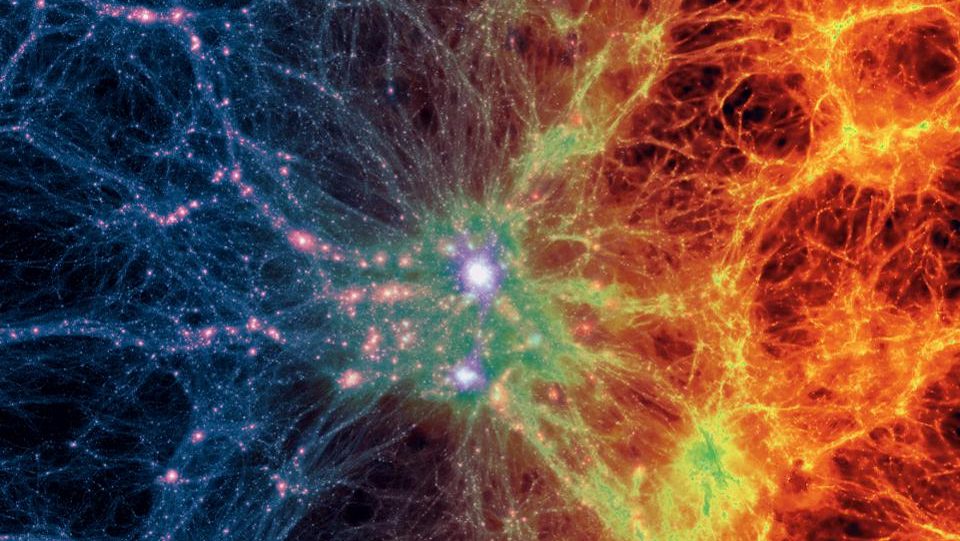Mysterious Galaxy Measured Exquisitely, And Contains No Dark Matter At All

A rare, ultra-diffuse galaxy is full of stars and not much else. Here’s how to make sense of it.
One of the greatest puzzles in the entire Universe is the dark matter mystery. In theory, for every bit of normal matter (like us) in the Universe, there should be approximately five times as much dark matter. Both normal and dark matter should experience gravitation equally, meaning that the largest structures in the Universe — galaxies, clusters of galaxies, and cosmic filaments — should contain and be dominated by dark matter. When we measure the motions of individual galaxies, both isolated and in clusters, the normal matter alone is not enough to explain what we see. Dark matter is also required.
But the Universe is also a violent place, full of mergers, collisions, and cosmic smash-ups. Some of these events should expel enough normal matter to create new, small, dark-matter-free galaxies: with normal matter alone. For the first time, scientists believe they’ve found one such galaxy with no dark matter, solving an enormous cosmic puzzle.
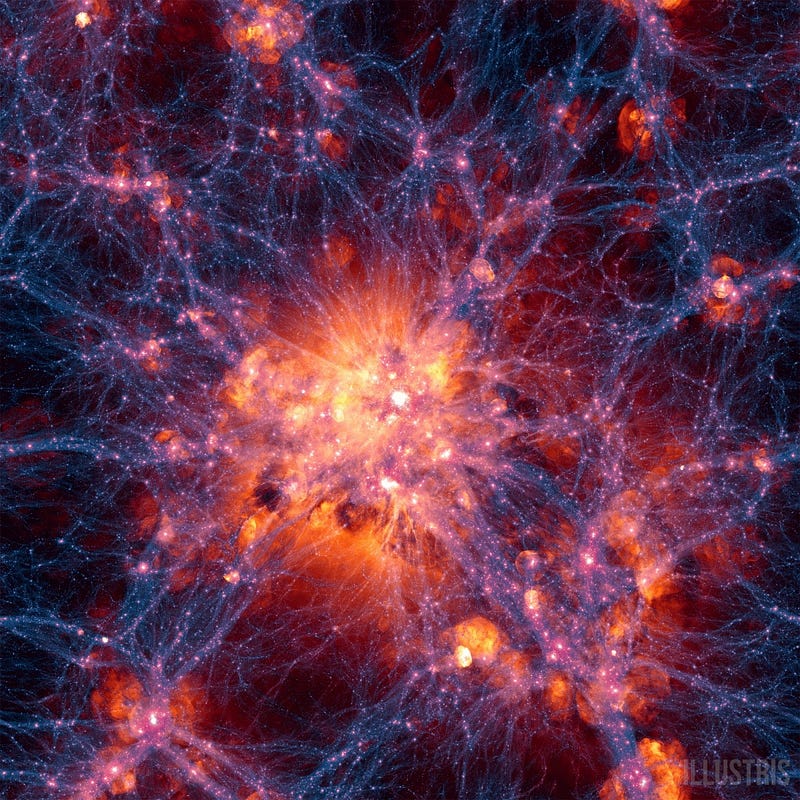
In theory, dark matter should be distributed almost-perfectly uniformly throughout the Universe, just like normal matter, after the Big Bang. As gravitation works to pull matter together into clumps, both normal matter and dark matter feel those effects, and pull themselves and one another together, forming overdense regions. When stars form, however, everything changes.
Normal matter collides, interacts, and heats up with other normal matter. It emits light and reacts to radiation pressure. Dark matter does none of these things, instead remaining in a diffuse halo. When a violent enough event occurs — such as a burst of star-formation, a collision of massive galaxies, or an active quasar — normal matter can get expelled from galaxies. This has the potential to create an unprecedented phenomenon: a collection of normal matter with no dark matter at all.

We have found many pieces of the puzzle consistent with this picture of cosmic structure. We’ve found large galaxies and clusters of galaxies with a universal ratio of dark matter to normal matter: 5-to-1. We’ve found galaxies, like ESO 137–001 (above), that have had their gas stripped from them, and now possess a greater than average dark matter fraction. We’ve found dwarf galaxies where star formation has expelled most of the normal matter, creating dark matter ratios as high as 600,000-to-1.
But we’d never found a galaxy made exclusively of normal matter, with no dark matter at all. Among the smallest dwarf galaxies, our theory of structure formation in a cold dark matter-rich Universe predicts that some of them should be composed of normal matter alone. In our local group, no such galaxies exist. But beyond our local group, the galaxy NGC 1052-DF2 (known as “DF2” for short) just might be the Universe’s proverbial missing link.
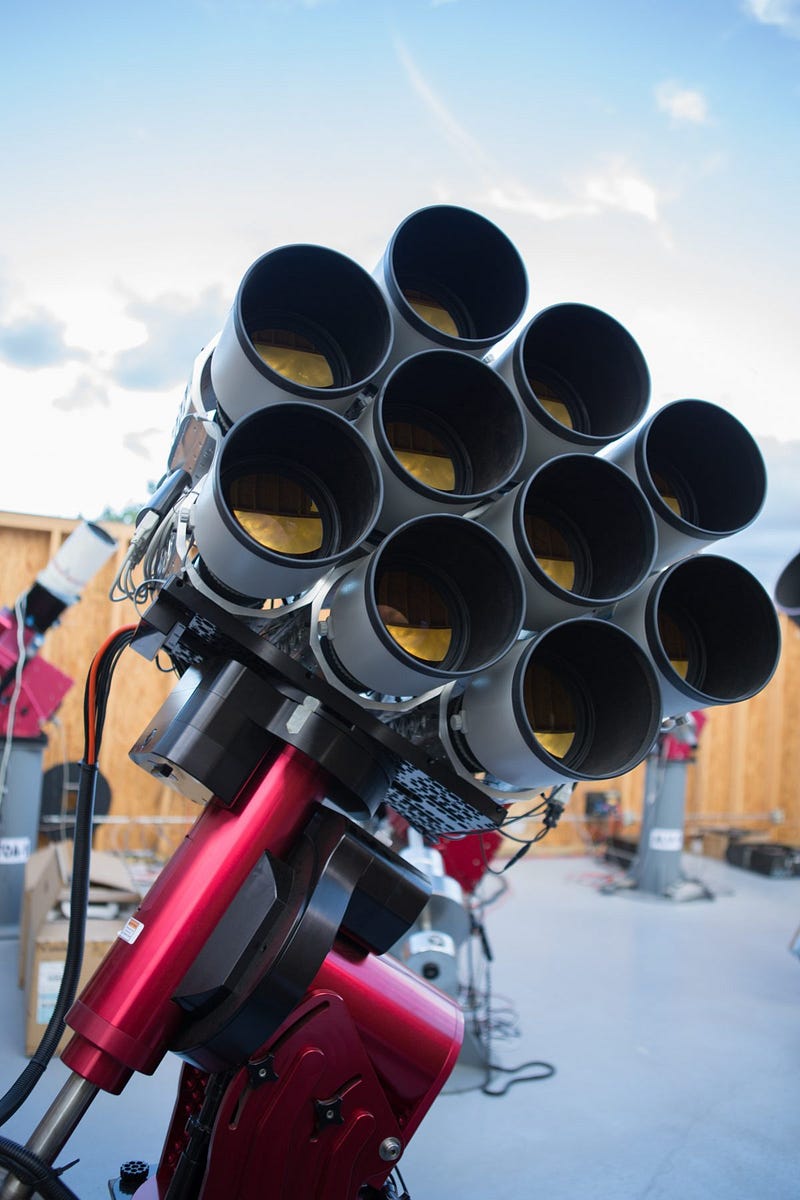
The way to find such a galaxy is to look beyond our Local Group, to a place that may have experienced more major and numerous smash-up events than we’ve seen. Instead of looking at the large, bright galaxies that emit the most light, we’d want to scour the diffuse outskirts of galaxy groups and clusters for low-mass, low-surface-brightness galaxies.
This means looking at a wide-field view of a portion of the sky to extremely faint brightnesses, and picking out any dwarf galaxies that exhibit a behavior unlike the others. The development of the Dragonfly telephoto array, which was recently upgraded to 48 telephoto lenses in two clusters, was made to do exactly this. When it pointed, back in 2018, at the massive elliptical galaxy NGC 1052, it found a number of dwarf galaxies surrounding it, including the most unusual one: DF2.
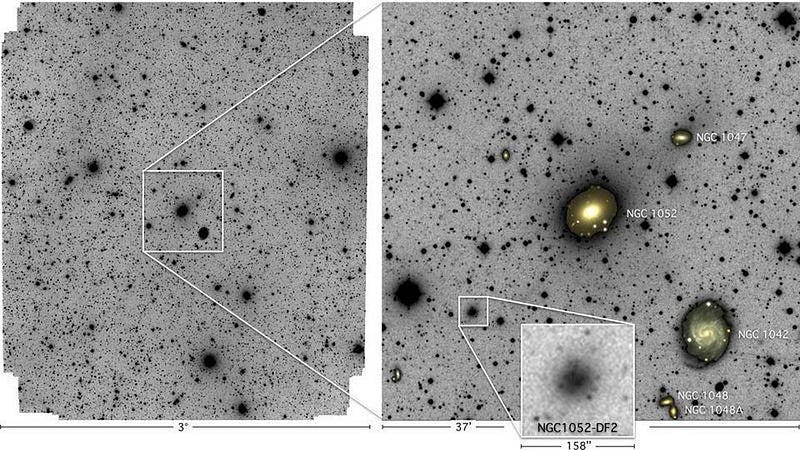
DF2 is strange, even for a dwarf galaxy. For starts, it’s ultra-diffuse, with no central core, no spiral arms, and no beehive-like elliptical structure. An instrument like Dragonfly is optimized for finding structures like this one with such low surface brightnesses; DF2 is one of only three or four known ultra-diffuse galaxies. It looks like a puffed-up ball of stars, and nothing more.
It is surrounded by a halo that’s populated with globular clusters, except its globular clusters are weird: they’re twice as large as the globulars we see in other galaxies. They’re also old: at least 9 billion years have passed since new stars have formed in them. But the strangest thing of all is that the motions of the stars inside of it, as well as the motions of the globular clusters around it, are so small. If dark matter were abundant, they’d move around at speeds of ±30 km/s, give or take a little. But that’s not what we see at all.
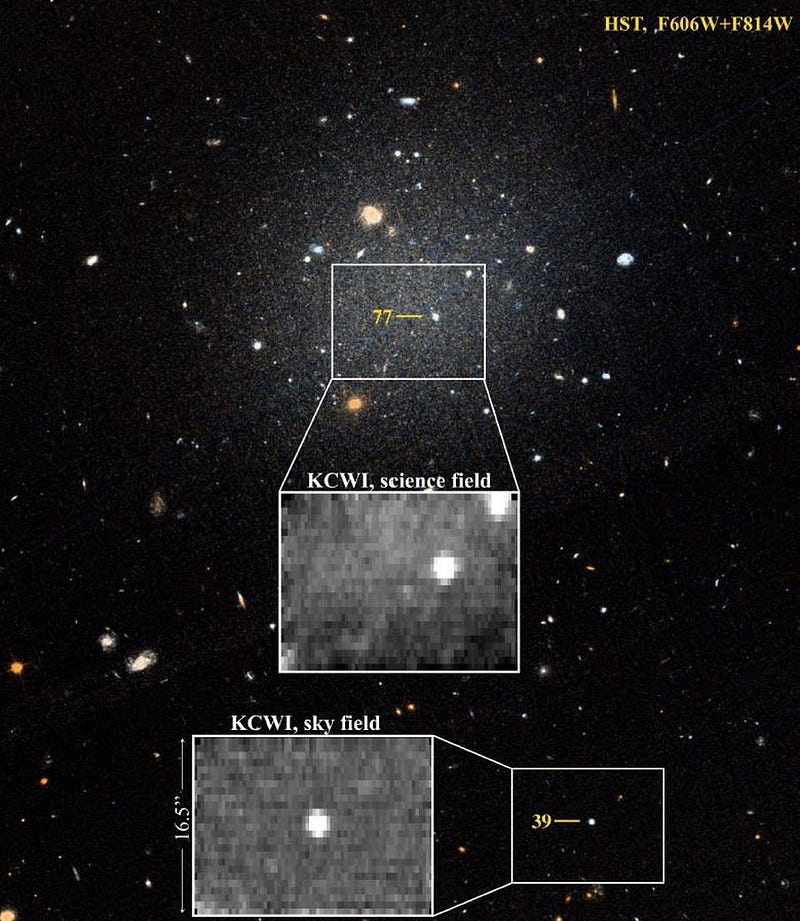
Initially, the globular clusters were used to constrain the total mass of this galaxy, finding that the internal motions were far less than what dark matter predicted. It was difficult to get an actual measurement; only an upper-limit that was below the predictions of standard dark matter models. Although the galaxy itself was much smaller than the Milky Way, it was still large enough — with nearly a billion stars overall inside it — to be a puzzling outlier.
There’s nothing like this ultra-diffuse galaxy in the Local Group, and we’d never seen such a small galaxy that looked to be devoid of dark matter entirely. If it were composed of normal matter alone, we’d expect its internal motions to display speeds of around ±6-to-8 km/s, which was below the measurement limit at the time. But using a clever technique with the MUSE instrument, an independent team reported that they’d measured the velocity dispersion from the stars directly, and got a result of ±16 km/s, showing that a substantial amount of dark matter was present after all.
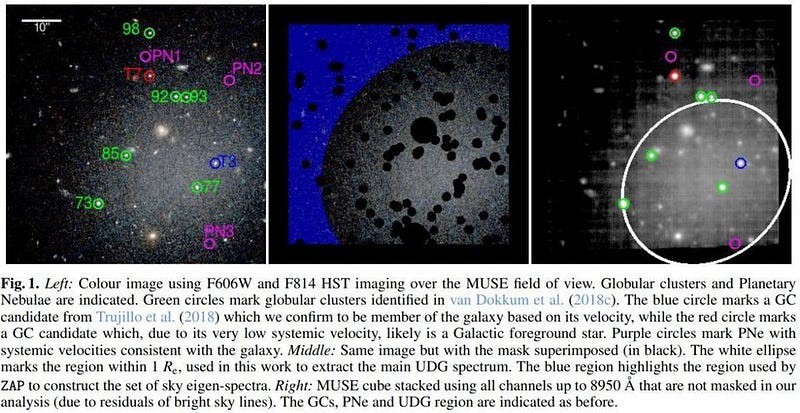
But was that value correct? I spoke with members of the original discovery team, and they contended that the MUSE instrument that they used had insufficient spectral resolution to make this measurement. You need a better instrument with a smaller field-of-view to get anything other than an upper limit, and that was why they were going to use the KCWI instrument instead of MUSE.
Earlier this month, they took their data and, below, you can see what they found. A sample spectrum from DF2 is shown as taken with KCWI, with the inferred spectrum from MUSE drawn (in red) atop it. As you can clearly see, the MUSE data is “smoothed out” because of insufficient resolution, which artificially inflates their results.
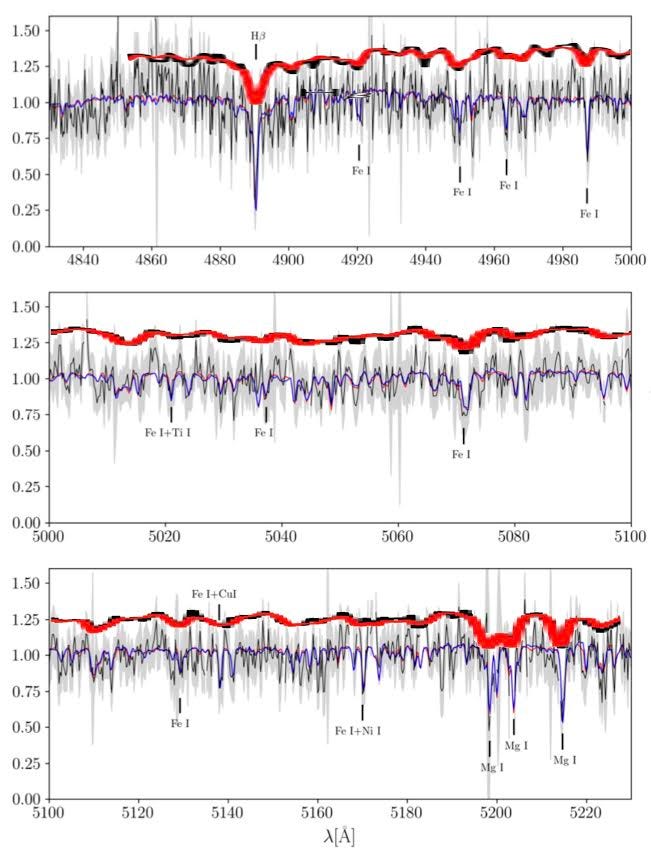
The stars and the globular clusters aren’t moving at ±16 km/s, as the prior team indicated, but at a mere ±7-or-8 km/s. By measuring the stars directly, they found a stellar velocity dispersion of ±8.4 km/s, while the globular clusters gave a slightly lower value of ±7.8 km/s. These values are consistent with what you’d expect from the mass of stars inside the galaxy alone; there appears to be no dark matter present inside this galaxy at all.
The globular clusters are found farther out than the stars by about a factor of 4, which is where the effects of a dark matter halo should be more significant. The fact that the the velocity dispersion remains unchanged between the stars and globular clusters, at least to the best resolution of our instruments, indicates that this galaxy may be the first example of a new population whose existence was predicted by theory: of ultra-diffuse, dark-matter-free galaxies.

The big question that now arises is whether this galaxy is a bizarre outlier, or whether it’s just the first example of many such galaxies that exist in the Universe. We know that there are many ways to separate out normal matter from dark matter, and that many of these mechanisms should result in the formation of large clumps of normal matter alone, completely isolated and separated from dark matter.
DF2 is the first example of such a galaxy, evolved and at late times, that appears to be dark matter-free. As the authors put it in their paper:
With this confirmation of the low velocity dispersion of NGC1052-DF2, the most urgent question is whether this “missing dark matter problem” is unique to this galaxy or applies more widely.
As the Dragonfly telescope now plans to cover the entire sky over the next year, it is expected that similar nearby galaxies may be waiting to be discovered.
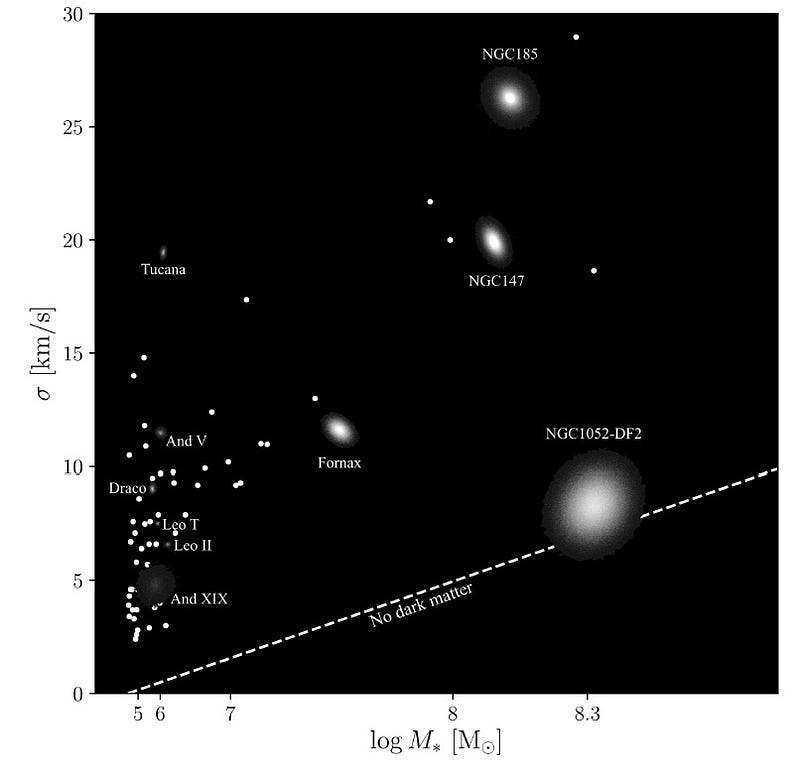
For the first time, we’ve identified and measured a galaxy that appears to be made of normal matter alone, with no need for dark matter or modifications to gravity at all to explain its motions. Ironically, the discovery of a galaxy without dark matter — amidst a sea of galaxies that require huge amounts of it — helps prove the validity of the dark matter-rich picture of the Universe. Only if normal matter can be separated out from the dark matter and left to form its own structures would such a galaxy be possible.
We’ve now confirmed that NGC 1052-DF2 is the first ultra-diffuse galaxy to display no evidence for dark matter inside of it, with its internal motions explicable from stars alone. There are still mysteries and puzzles surrounding this cosmic oddity, but with more and better data forthcoming, we should fully expect to find that there are many more like it out there. The Universe never ceases to amaze us.
Ethan Siegel is the author of Beyond the Galaxy and Treknology. You can pre-order his third book, currently in development: the Encyclopaedia Cosmologica.
